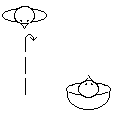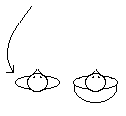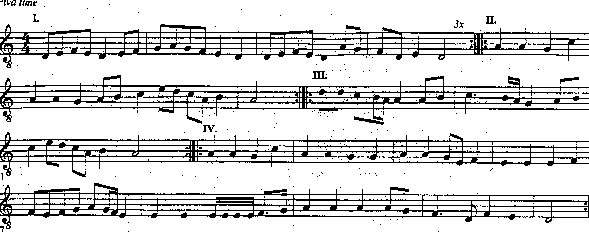Steps: Piva (in 4), Reverenza.
Start: One couple, side by side, holding hands, Woman on the right, facing up the hall.
[2-bar introduction on accompanying tape] | ||
| 1-4 (3 times) | 12 Pive, starting on Left foot. | |
 Bars 13-16 | ||
| 5 | Man Step Left, Step Right. | |
| 6 | Man Piva Left. | |
| 7 | Man Step Right, Step Left. | |
| 8 | Man Step Right, (this is the half-length bar). | |
| 5-8 (2ndtime) | Woman same to catch up. | |
| 9-11 | Man Piva Left, Piva Right, Piva Left. | |
| 12 | Man Step Right (half bar). |  Bars 18-21 |
| 9-12 | (2nd time) Woman same to catch up. | |
| 13 | Man Step Left, Step Right. | |
| 14 | Man Piva Left. | |
| 15 | Man Step Right, Step Left. | |
| 16 | Man Step Right, and pivot to face Woman, keeping weight on right foot. | |
| 17 | Both Reverenza Left, facing each other. | |
| 18-21 | Man Piva Left, Piva Right, Piva Left, Step Right (the half-length bar), rejoining Woman, and turning to face up the hall. (End side by side, facing up the hall.) | |
13-21 (2nd time) | Repeat, Woman leaving and returning as Man did.
(End as started dance, side by side, facing up the hall, man on the left.) | |
| Repeat the dance, Woman doing everything first this time. | ||
Teaching Notes
It may be useful to note that the dance has the following pattern:
Entrance (12 Pive).
Man does Sequence A (Step Step Piva Step Step Step). Woman
repeats.
Man does Sequence B (Piva Piva Piva Step). Woman repeats.
Man does Sequence A, turns, both Reverenza, Man
returns with Sequence B. Woman repeats.
Recordings
Bel Danzare - Short introduction. Section IV is a bit shorter, so leave off Bar 21, returning to partner with only three pive. Repeats the dance after a short pause.
Danzare - No introduction. Section I is only played twice, so do eight instead of twelve pive at the beginning. The half-length bars are extended to full bars, so in Bars 8, 12 and 21, replace the step with a piva, or add a pause to the end of the step. Repeats dance.
Light - Three-bar introduction. Works with this reconstruction. Repeats dance.
Music Richard - One long note for an introduction. Quite slow so, if you prefer, use doppio and sempio in place of piva and step. Section I is played only twice so do eight pive instead of twelve. All the half-sized bars (8,12 and 21) are full bars, so add a pause or turn the step into a piva. The dance is played three times; the second time is a tad confusing at first.
Musica Italiana - No introduction. Section I has an extra bar thrown into the middle and is played twice instead of three times, so do ten pive instead of twelve. Section IV is only played once for each repeat of the dance, instead of twice, so the man should do it the first and third time, and the woman the second. All the half-sized bars (8,12 and 21) are full bars, so add a pause or turn the step into a piva. The dance is played three times.
Return - Two-bar introduction. An extra ten bars of music appear at the very end. Quite slow so, if you prefer, use doppio and sempio in place of piva and step. Section I is played only twice so do eight pive instead of twelve. Section IV is played only once for each repeat, so the man and woman should alternate doing it. All the half-sized bars (8,12 and 21) are full bars, so add a pause or turn the step into a piva. Plays dance four times with an extra bar between the first and second time, and between the second and third.
Dance Notes
There is also a three-person version of Amoroso.
No author is given in any of the sources. PnA lists it as a ballo francese, so it may have been a French dance, or an Italian version of a French dance, or what the Italians imagined the French to be dancing. This reconstruction is based primarily on NYp (the one exception is noted below for Bars 20-21 (2nd time)), which doesn't refer to it as French.
Bar 16: The sources don't specify a step for the turn, and don't use the usual term mezavolta. There doesn't seem to be any music given to it, so it could be done as the step is taken, rather than after it. Section IV is eight bars long, which fits a choreography of 3.5+1+3.5 bars. We originally tried this, but discovered that the bar length might be correct, but dancers had a great deal of difficulty following the music. Instead, we added a half bar at the end of Bar 16, and used it for the turn. This also resulted in the same rhythmical pattern occurring for the three pive and step, in Bars 18-21, as occurred in Section III.
Bar 13 (2nd time): This section in NYp starts by saying "la domna vadi imnanzi a fare la riverenzia al uomo chon dua passi di natura ...", which looks as if she might be starting with a reverenza, but more likely indicates the whole sequence is, in a sense, a reverence. The woman's step sequence is otherwise given identically to the man's.
 Bar 20-21 (2nd time): In NYp, the man is instructed to come to meet the woman and
turn, with a piva and a step. This was left out in order to make
the dance even simpler. It is not present in PnA, although that version
differs also in that the man did not return to the woman, but only circled,
nor is it present in Ngm, where the man has returned to his partner.
Bar 20-21 (2nd time): In NYp, the man is instructed to come to meet the woman and
turn, with a piva and a step. This was left out in order to make
the dance even simpler. It is not present in PnA, although that version
differs also in that the man did not return to the woman, but only circled,
nor is it present in Ngm, where the man has returned to his partner.
If it is desired, this part can be added, as follows:
| 20-21 (2nd time) | Woman Piva Left, Step Right, (not turning), |
| as | Man Piva Left, Step Right, joining Woman and turning. (Dancers end side by side, Man now on the right, facing down the hall. |
Repeat: None of the sources call for a repeat, but as NYp ends with the couple having changed positions, it is probable that a repeat, with reversed roles, is expected in that version.
Music Notes

We made two changes to the music for this dance. The first was in Bar 4; Ambrosio wrote two semibreves as the last two notes. This left an incomplete bar, and the dance does not call for a shortened bar. Further, the other sections of this dance all end with breves. We therefore believe this last semibrevis to be an error and have changed it to a brevis.
The other change is in the final two bars. The manuscript has this dance ending with three minimae and then a brevis. However, this causes the final brevis to be tied across a bar, unless we change the length of one of the bars in this section. Nothing in the dance suggests this. The dance calls for 8 bars of music if we assume the pivot in Bar 16 takes no time and 8.5 bars otherwise; we decided to extend the music to 8.5 bars. To address these concerns, we changed the last two minimae to semibreves. The literal transcription of the last section is as follows:
